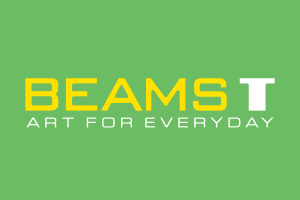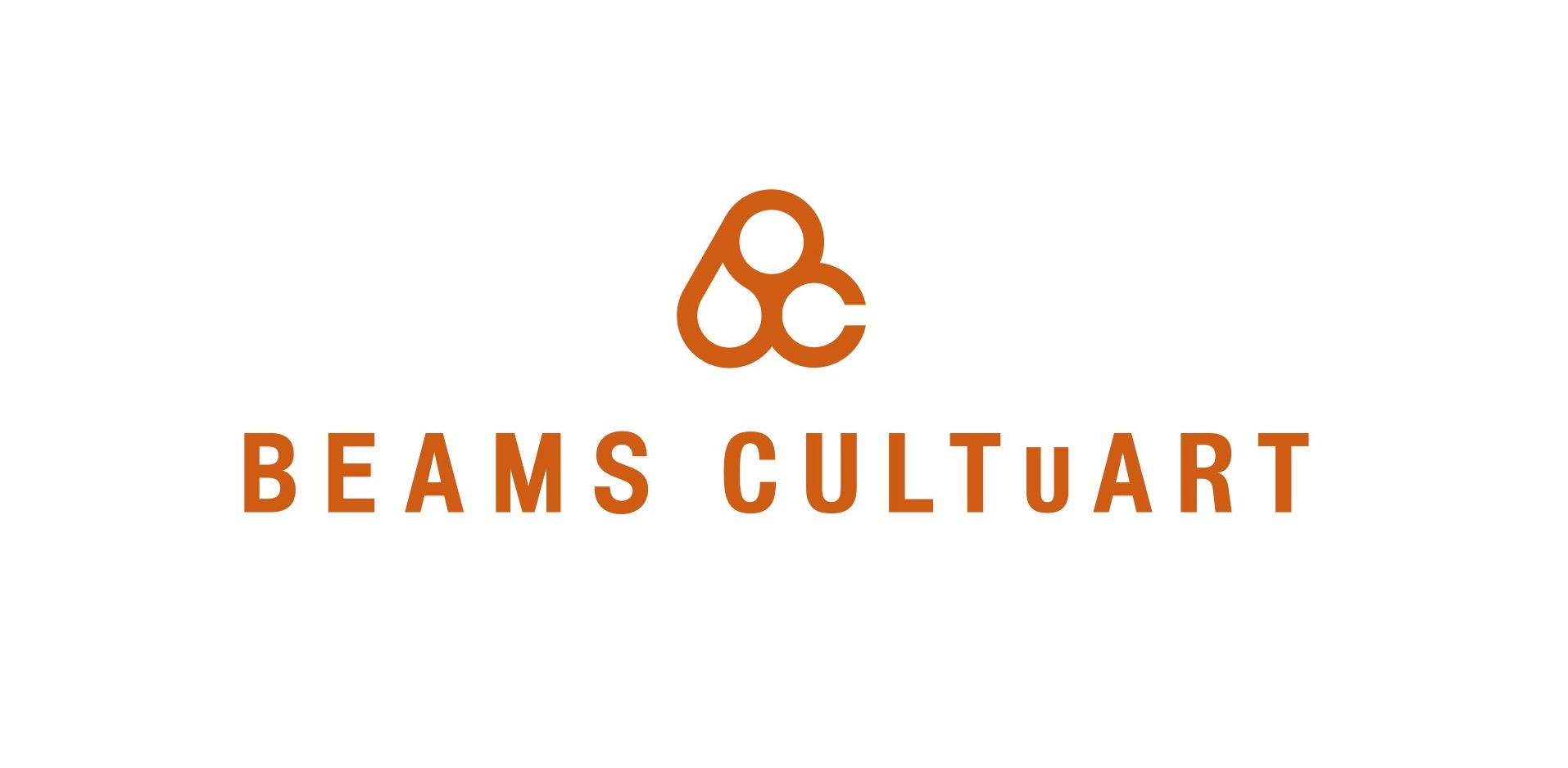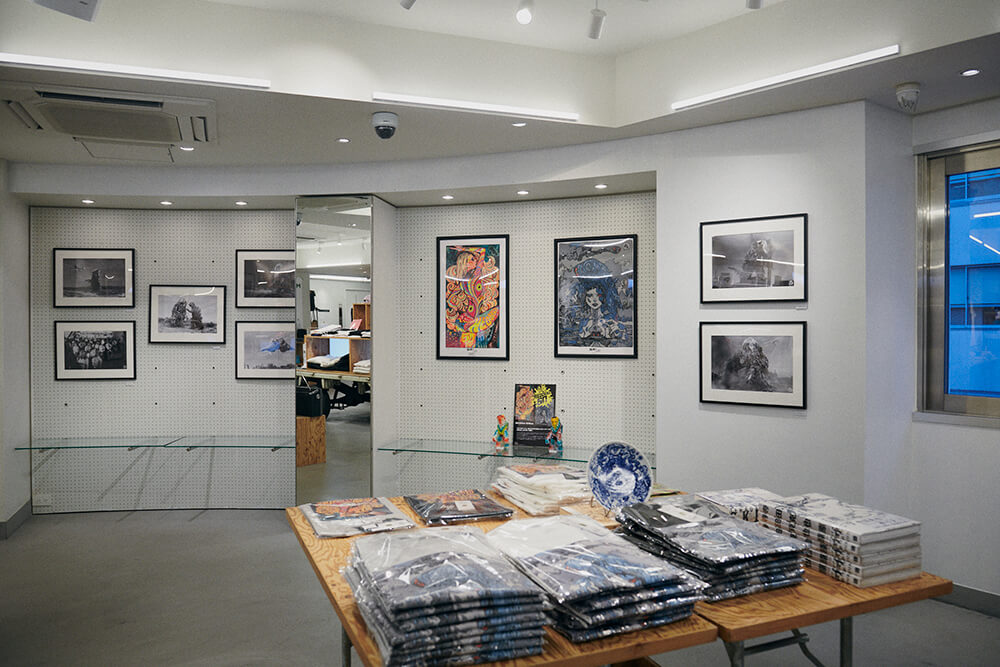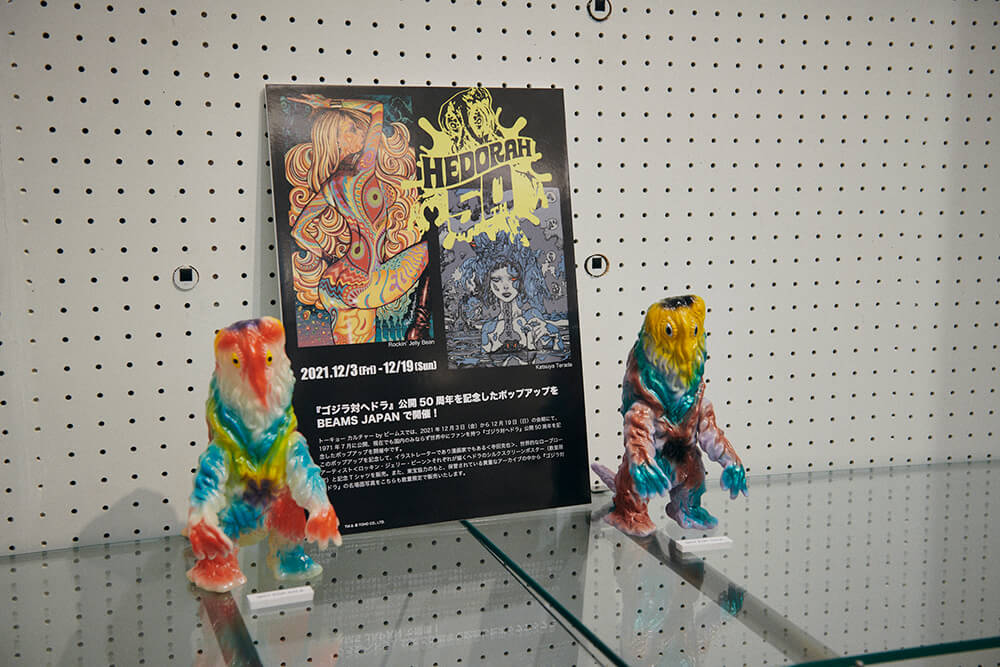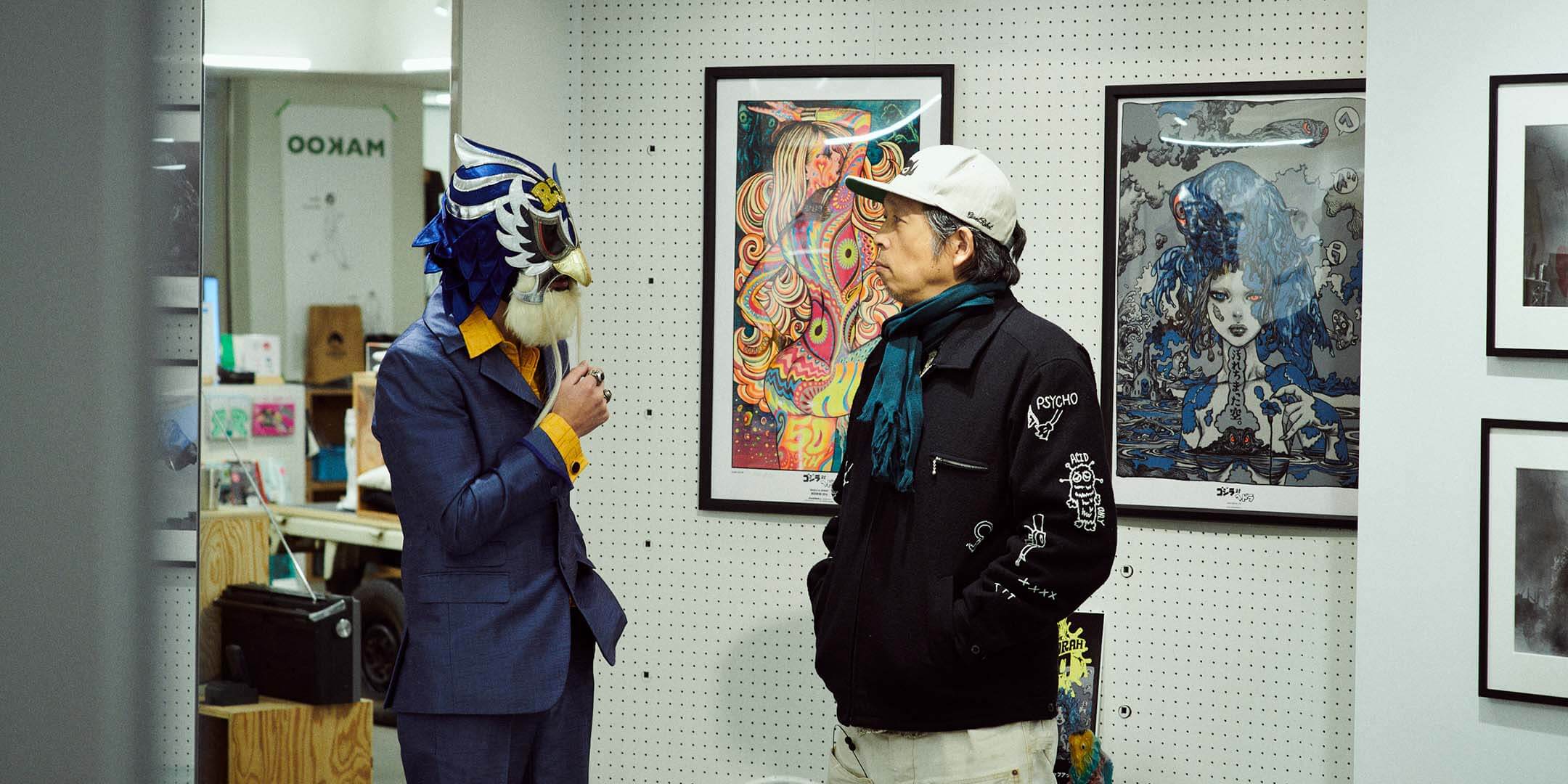
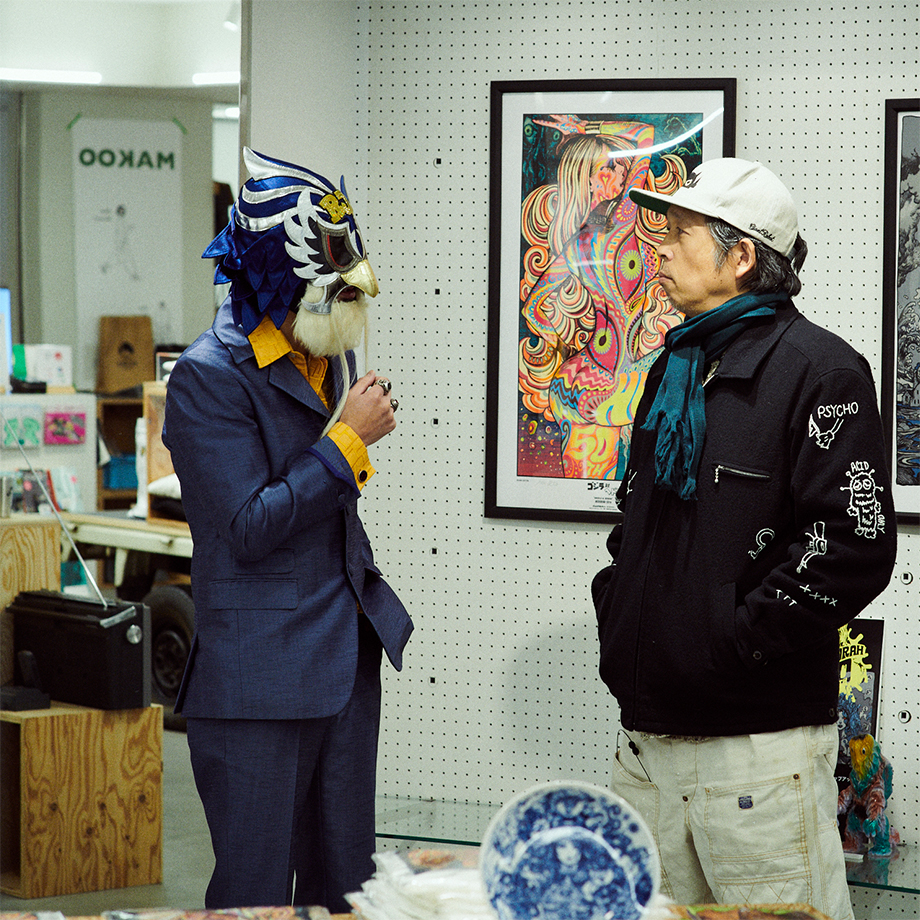
ロッキン・ジェリービーンと寺田克也が語る、『ゴジラ対ヘドラ』の魅力。
Rockin' Jelly Bean and Katsuya Terada talk about the appeal of "Godzilla vs. Hedorah".
世界中を魅了し続ける怪獣、ゴジラ。1954年に1作目が劇場公開されて以来、数々の名作が生まれてきました。なかでも熱狂的なファンが多いのが、シリーズ11作目の『ゴジラ対ヘドラ』です。2021年に公開50周年を迎えたことを記念して、<トーキョー カルチャート by ビームス(TOKYO CULTUART by BEAMS)>では、ポップアップストアとコラボレーションアイテムを制作しました。アニバーサリーを祝うべく本イベントに参加してくれたのは、ロッキン・ジェリービーン(Rockin’Jelly Bean)さんと寺田克也さん。親交が深いからこそ繰り広げられた軽快なトークで、お二人にとっての『ゴジラ対ヘドラ』、今回の作品についてをお届けします。
Godzilla is a monster that continues to fascinate the world, and since the first film was released in theaters in 1954, many masterpieces have been created. Among them, the eleventh film in the series, "Godzilla vs Hedorah," has many enthusiastic fans. In 2021, to commemorate the 50th anniversary of the film's release. TOKYO CULTUART by BEAMS has created a pop-up store and collaborative items. Rockin’ Jelly Bean and Katsuya Terada participated in this anniversary event. In a delightful talk that was made possible by their close friendship, the two talked about "Godzilla vs Hedorah" and the collaborative items..
PROFILE
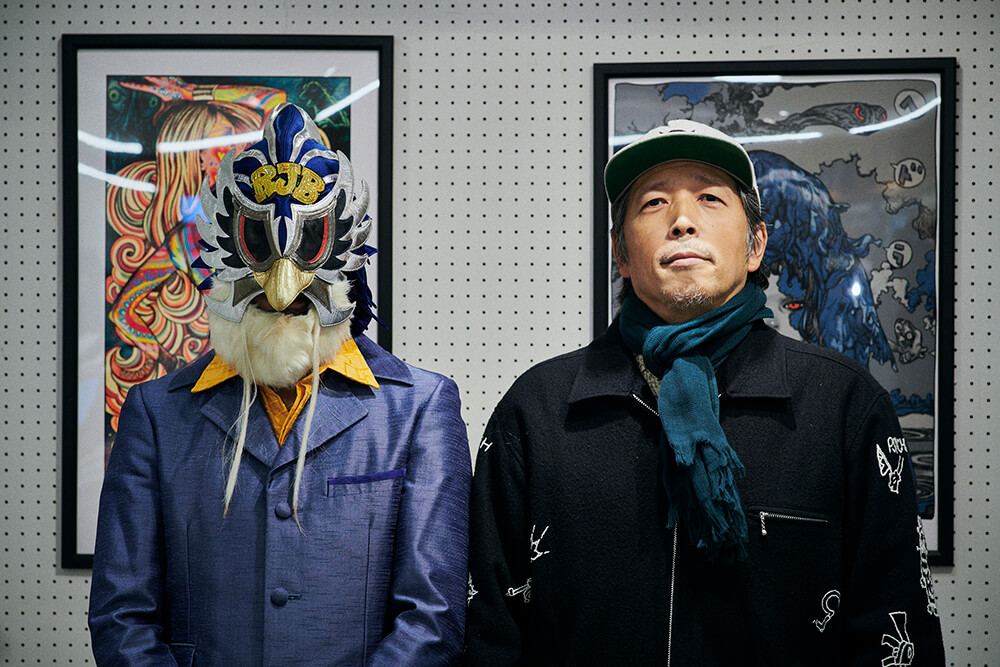
左:Rockin’Jelly Bean
1990年に活動を開始した覆面のローブローアーティスト。ガレージバンドシーンのフライヤーや、レコードジャケットで人気を博し、海外にも名前を轟かす。2004年には、自身の作品やグッズなどを取り扱うショップ「EROSTIKA」を原宿にオープンした。3人組のインストゥルメンタル・バンド、Jackie & THE Cedricsではベースを担当する。
右:寺田克也
漫画家、イラストレーター。ゲームやアニメのキャラクターデザイン、器にイラストをあしらった「寺田器」など活動の幅は広く、国内はもちろん、海外にもファンが多い。代表作に漫画『西遊奇伝大猿王』や『ラクダが笑う』、画集には『寺田克也全部』など。キャラクターデザインでは、ゲーム『バーチャファイター2』などを手掛けた。近著は『寺田克也SKETCH』。
気づけば切磋琢磨していた、二人の関係。
ー お二人は、いつからのお付き合いなんですか?
ロッキン・ジェリービーン(以下、RJB):あまり公の場で言う機会無かったんですが実は自分達、いとこ同士なんですよ。昔から絵が上手な“カツヤ兄ちゃん”って呼んでて、いつも背中を追いかけていました。ぼくが上京してきてからもよくご飯とか連れて行ってくれて、お世話になっていました。
寺田:…んー、それ、全部嘘ですよ!
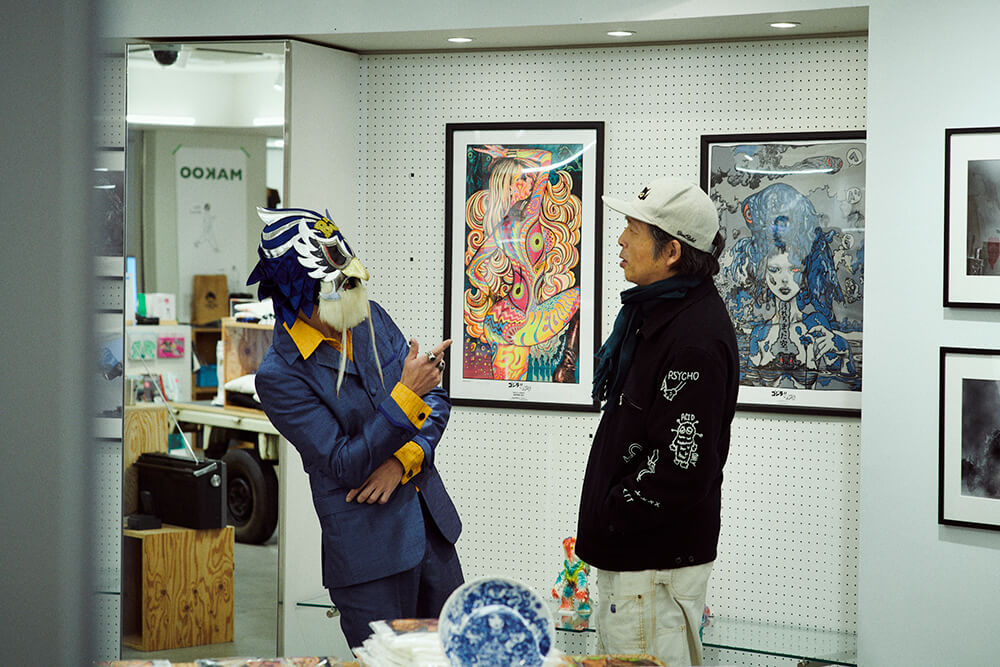
RJB:ダメじゃないですか、言っちゃ! まあ、オレが昔から背中を追いかけてきたのは本当です。寺田さんの絵が好きで、寺田さんが描く漫画も読んでいました。いつまでも超えられない目標のひとりです。
寺田:それで言ったらオレも。ジェリービーンは、オレが描こうとしている絵を全部描いてたなー。
RJB:え!? それはありえない! 例えば?
寺田:『発狂する唇』とか。
RJB:それを言ってくれるのは、レアですね! ずいぶん昔なんですが、『発狂する唇』というホラー映画のポスターを描かせてもらったことがあったんですよ。
寺田:ロッキン・ジェリービーンと書いてあったから、最初は海外の人だと思っていたなー。国籍も年齢も分からないから、ずっと遠い存在でした。作品を観て刺激をもらっていて、すごく影響を受けていましたね。ああいうエロい女の子を描く人を見たことなかったので、参考にしようって。オレは女性を描くのが苦手だったから…。
RJB:女の子を描くのが苦手だったなんて、信じられます? でも、本当に嬉しいです。けど寺田さんは、『激漫』(ワニマガジン社)の表紙でセクシーな女の子いっぱい描いていたじゃないですか。あの時はどういったテンションで描いていたんですか?

寺田:『激漫』というエロ漫画雑誌の表紙を毎月描いていたんですけど、それまではかわいい女の子を描くのは照れがあって避けていたんですよ。でも、表紙だから訴求する表情を描かなきゃいけなくて。オレの中では、当時、リアルと漫画の境界を描いていたのがジェリービーンや村田蓮爾だったから、魂をコピーさせてもらっていました! それでオレも、女の子を描いてもいいのかな、と思うようになったんですよ。
RJB:それを観て、オレも勉強して描いていましたからね。
寺田:結局、そうなんだよね、影響しあう。海外の作家も、こっちが参考にしていたら、向こうもオレのことを知ってくれてたりね。
RJB:好きなものが似ていると、会ったことがなくてもシンパシーを感じますよね。
寺田:それは、どうしても作風に出てしまうものだと思います。
芸術性を感じる日本の怪獣。

ー 話が盛り上がりすぎて入る隙がなかったです(笑)。では、本題の『ゴジラ対ヘドラ』のお話を。初めて観たのはいつごろでしたか?
寺田:ゴジラシリーズをきちんと観たのは二十歳を過ぎてから。映画館に行く習慣のない家庭だったので、子どものころに劇場で『ゴジラ対ヘドラ』を観ていないんですよ。でも、本で観てて、もちろん当時から知っていましたよ。写真でヘドラを観て、想像するだけでもおもしろかった。
RJB:うちもゴジラを観に行く家庭じゃなかったから、同じく友達の家にあった本でヘドラを観ていました。最初に『ゴジラ対ヘドラ』を観たのは20代。絵描きの仲間のあいだで、『ゴジラ対ヘドラ』は異色だと話題になって。怪獣映画としてではなく、サイケデリックな側面から入りました。
寺田:子どもの頃に映画を観ていたら、あのサイケデリックな映像を受け入れられなかったかもしれないね。
TM & © TOHO CO., LTD. 1971年に劇場公開された『ゴジラ対ヘドラ』からの一コマ。
ー 1971年公開という時代性もあって、サイケデリックな要素やヒッピーカルチャーといった部分も感じる作品ですよね。
RJB:公害をテーマにしていて、かなり時代性が強い作品だと思います。
寺田:一周回って、現代の環境問題ともリンクしているようにも感じますね。そういった意味では、現代版のヘドラを観てみたい。
RJB:おもしろそうですね! 現代版のヘドラ。
ー 印象に残っているシーンはありますか?
RJB:バーのシーンですね。都会には、あんなにきれいな姉ちゃんが踊っているお店があるんだ!って子どもの頃に、写真を観て思ってた。あとはゴジラがヘドラの目玉をくり抜くところね。
寺田:あの残酷な描写ね。オレはヘドラの造形が印象に残っています。ヘドラの形態が変わっていくのもいい。だから、今回の作品にはヘドラの4形態を描いてみました。
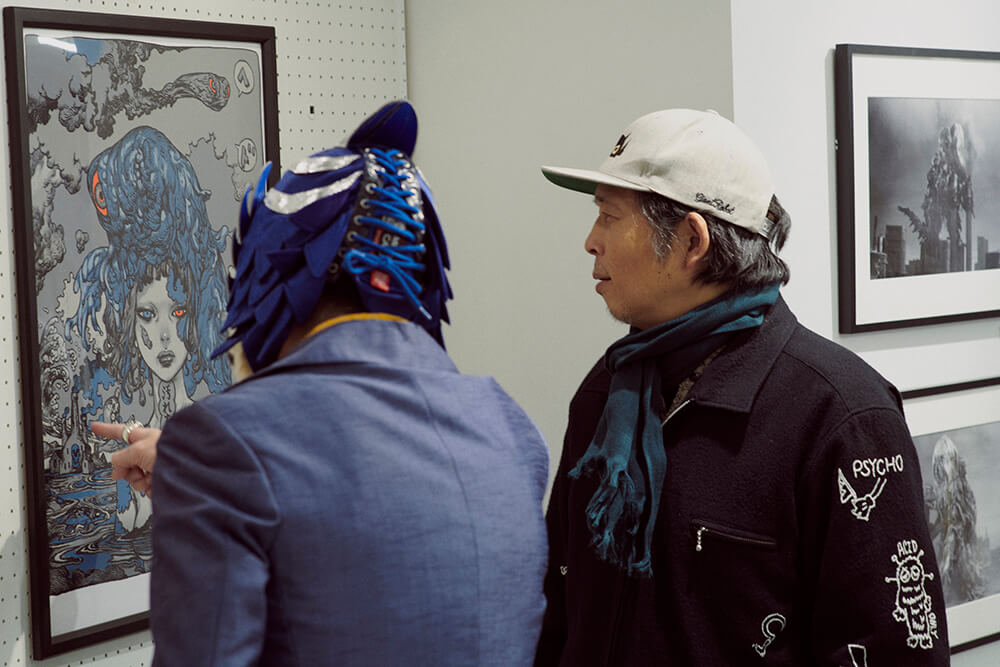
ー ヘドラは、ゴジラシリーズに登場する他の怪獣の中でも異質な印象ですよね。
寺田:縦になっている赤い目なんて、子どもは怖がりますよ。でも、ドロドロしているシルエットにその目を描くだけでヘドラになるからすごい。
RJB:確かに。あまり意識していませんでしたが、縦になっている目って、他にあまり思いつきませんね。
寺田:そこもまた、サイケっぽいデザイン。日本は延々と、怪獣や怪人を生み出し続けていて、そのデザインが素晴らしい。アメリカなら怪獣を人型や恐竜型や昆虫型など、存在するものを大きくしているイメージです。でも、日本の場合は少し違ったデザインに仕上がっていると思う。
RJB:そうですね。日本の怪獣には芸術性を感じます。
寺田:ヘドラは怪獣としては異質なデザインだけど、それをスッと受け入れられるのもすごいところ。それに、ヘドラって名前もいいよね。
ー 寺田さんは、映画『ゴジラ FINAL WARS』でモンスターXをデザインされました。ゼロから怪獣をデザインするのはやはり難しいものですか?
寺田:商業作品なので、観る人ありきでデザインしなければいけません。完全に空想のものをデザインすると、観る人は付いていけなくて、理解できなくなってしまう。だから、現実に存在するものを少しだけフックに使うテクニックもあるんです。単純に犬をそのまま巨大化させるのではなく、犬の要素を少し入れるだけで、犬っぽい怪獣として受け入れてもらえる。みんなが持っている共通認識をどこかに入れると、少しだけ親和性が上がります。
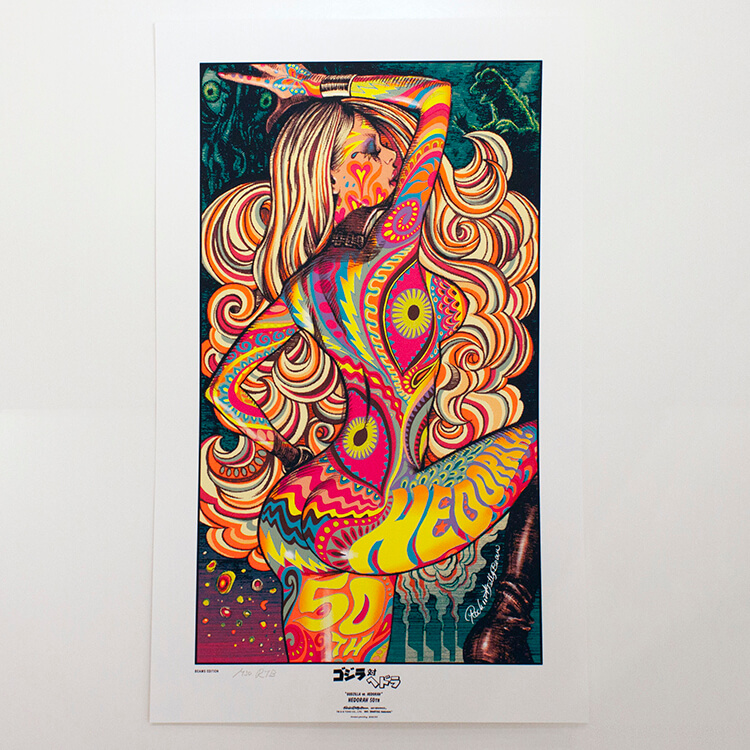
TM & © TOHO CO., LTD. ロッキン・ジェリービーンさんの作品。
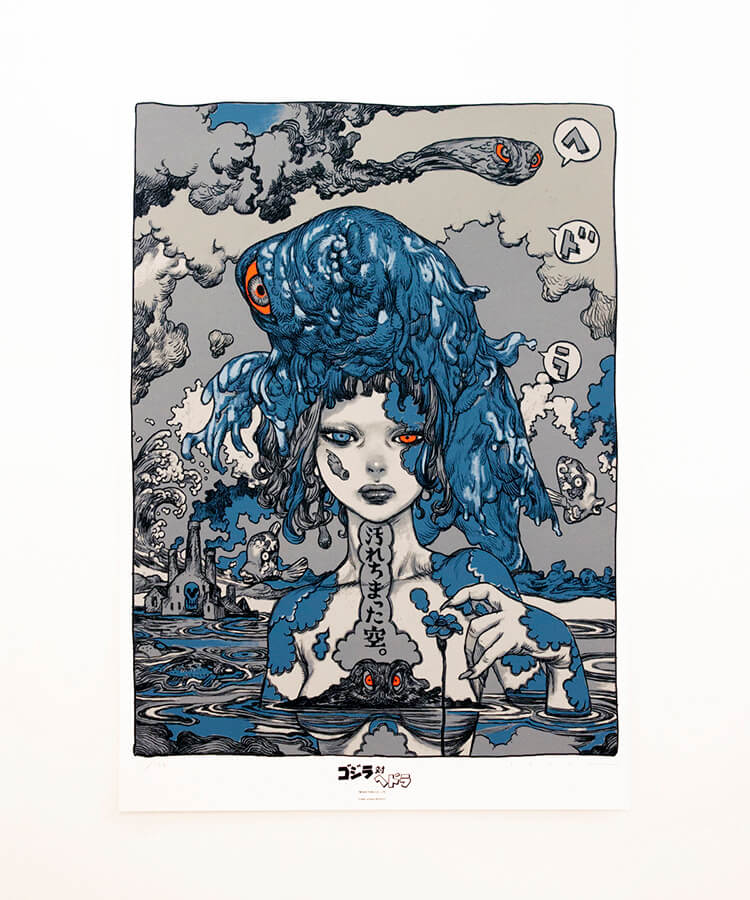
TM & © TOHO CO., LTD. 寺田克也さんの作品。
ー そんな中、ヘドラはヘドロがモチーフで、一見して分かりにくい造形です。それでもヘドラにファンが多いのは、デザインが優れている証拠なのかもしれませんね。今回『ゴジラ対ヘドラ』をテーマに描いていただきましたが、お互いの作品を改めて観て、いかがでしたか?
寺田:あいかわらず構成がかっこいいと思いました。パッと観ただけで迫るものがあります。
RJB:そう言っていただけると、本当にありがたいです。
寺田:これで何色使っているの?

RJB:13色ですね。だから、シンプルなビジュアルなのに、いつも以上にシルクスクリーンの版をつくる作業に時間がかかってしまって。寺田さんの20倍くらいの時間がかかりましたよ(笑)。
寺田:失礼だな! 3年くらい掛かったよ。
RJB:3年って(笑)。ポップアップのビジュアルが完成するまで寺田さんの作品を観ていなかったんですが、観たらヘドラがカッコいいし、女の子はかわいい。やられた〜、さすがだなと思いました。
寺田:色が対照的だから、二つ並べて飾ってもらいたいですね。
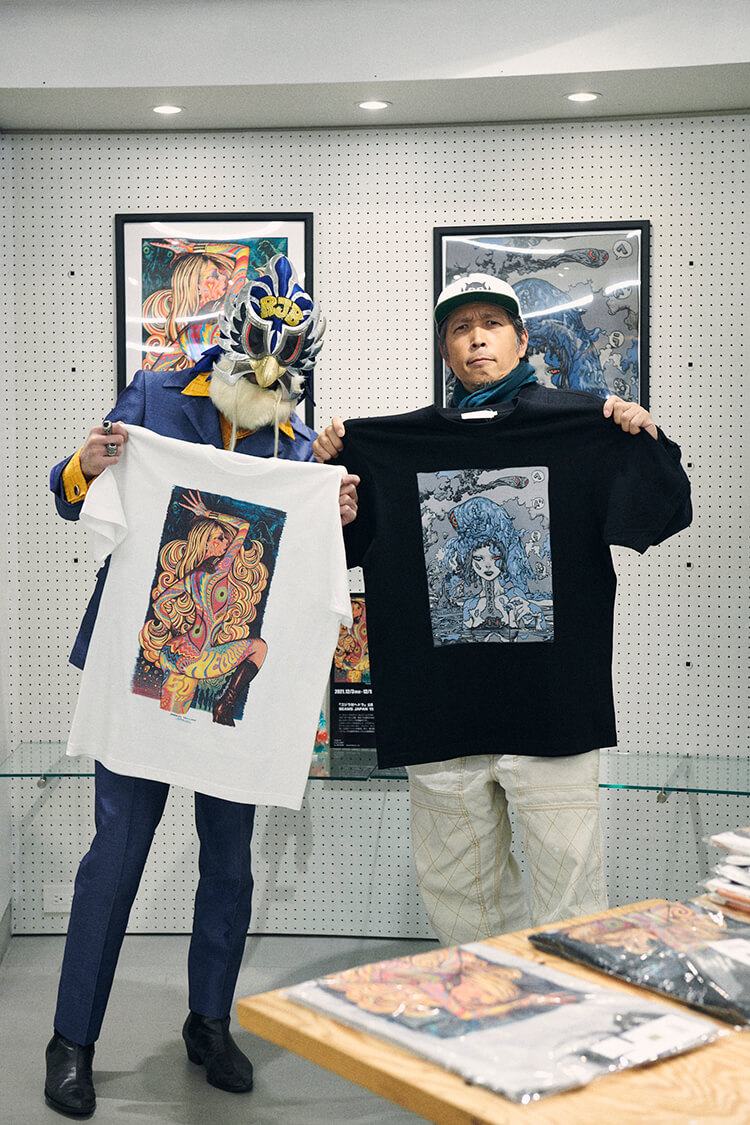
お二人の作品は、シルクスクリーンのポスターの他、
Tシャツでも販売。こちらから購入可能です。
ー では、お二人にとってゴジラとはどういう存在なのでしょうか?
RJB:現実でも、ビルの影からゴジラが出てくるんじゃないかと思わせてくれるところがいい。ゴジラが街をめちゃくちゃにしてくれるデストロイなところも好きですね。想像を巡らせてくれる、夢のような存在です。
寺田:オレもそう。ゴジラは現代社会に出てくる怪獣だから、いろんなものに置き換えることができると思います。圧倒的な力の象徴として、唯一無二の存在。ジェリービーンが言ったように、街中に出てきそうと思わせてくれる怪獣は簡単につくることができませんし、ゴジラに代わる怪獣はなかなか現れない。そんなキャラクターを描いてみたいなと、ふとビルの向こうを眺めるたびに思ってしまいます。
PROFILE

Left: Rockin’ Jelly Bean
Rockin’ Jelly Bean is a masked lowbrow artist who started his career in 1990. He became popular for his flyers and record jackets for the garage band scene, and made his name overseas as well. In 2004, he opened his own store, EROSTIKA, in Harajuku, Tokyo, selling his works and other goods. He plays bass in Jackie & the Cedrics, a three-piece instrumental band.
Right: Katsuya Terada
Manga artist and illustrator. He has a wide range of activities, including character design for games and anime, and “Terada Vessels,” which are vessels decorated with illustrations, and has many fans in Japan and overseas. His representative works include the comic books “Saiyukiden Daienou” and “Rakuda ga warau”, and the art collection “Katsuya Terada All”. His work as a character designer includes the game “Virtua Fighter 2”. His most recent book is “Katsuya Terada SKETCH”.
Having a friendly rivalry.
ー How long have the two of you known each other?
Rockin’ Jelly Bean (RJB): We haven’t had a chance to say this in public, but we’re actually cousins. I always called him “Brother Katsuya” because he was so good at drawing, and I always followed his footsteps. After I came to Tokyo, he often took me out to dinner and helped me a lot.
Terada: Hmm, that’s all a lie!

RJB: You can’t say that! Well, it’s true that I’ve been following him for a long time. I always liked his drawings, and used to read the manga that he drew. He is one of my goals that I will never be able to surpass.
Terada: Then there’s me. Jelly Bean used to draw all the pictures I was trying to draw.
RJB: What? That’s impossible! For example?
Terada: “Crazy Lips”.
RJB: You are an odd person to say that! It was a long time ago, but I was asked to draw a poster for a horror movie called “Crazy Lips”.
Terada: It said “Rockin’ Jelly Bean” on it, so at first I thought it was someone from overseas. I didn’t know his nationality or age, so I felt he was distant from me. I was inspired by his works, and he influenced me a lot. I had never seen anyone draw such erotic girls before, so I tried to use his work as a reference. I was not good at drawing women, so…
RJB: Can you believe that he was not good at drawing girls? But I’m really happy to hear that. But you drew a lot of sexy girls on the covers of “Gekiman” (Published by Wani Magazine), didn’t you? What kind of mindset were you in when you were drawing them?

Terada: I used to draw the cover of an erotic manga magazine called “Gekiman” every month, but before that I was shy about drawing cute girls and avoided it. But since it was the cover, I had to draw an appealing expression. In my mind, at that time, it was Jelly Bean and Renji Murata who were drawing the boundary between real life and manga, and I was following their vibe. That’s when I started to wonder if it was okay for me to draw girls, too.
RJB: For my part, I saw your cover girls, studied, and drew mine.
Terada: In the end, yes, we do influence each other. The same applies to the foreign artists. When I refer to their works, they also know about me.
RJB: If you like the same things, you empathize with each other even if you’ve never met.
Terada: I think that’s something that inevitably comes out in your style.
An artistic quality of Japanese monsters.

ー The two of you were having so much fun talking that there was no room for me to jump in (laughs). Now, let’s talk about the main topic, “Godzilla vs. Hedorah” When was the first time you saw it?
Terada: I didn’t properly watch the Godzilla series until I was over 20 years old. I was from a family that didn’t have the habit of going to the cinema, so I didn’t see “Godzilla vs. Hedorah” in the theater as a child. But I had seen it in books, and of course I knew about it from then on. It was interesting enough to see Hedorah in pictures and just imagine it.
RJB: We weren’t a family that went to see Godzilla either, so I saw Hedorah in a book that was also at a friend’s house. I first saw “Godzilla vs. Hedorah” in my twenties. Among my fellow painters, there was a lot of talk about how “Godzilla vs Hedorah” was unique. I encountered the film not as a monster movie, but as a psychedelic movie.
Terada: If I had seen the movie as a child, I might not have been able to accept those psychedelic images.
TM & © TOHO CO., LTD.
A scene from “Godzilla vs. Hedorah,”
which was released in theaters in 1971.
ー “Godzilla vs. Hedorah” was released in 1971, so you can feel the psychedelic elements and hippie culture in this film.
RJB: It’s about pollution, and I think it reflected the spirit of the times.
Terada: History repeats itself, and now it seems to be linked to contemporary environmental issues. In that sense, I’d like to see a modern version of Hedorah.
RJB: That sounds interesting! A modern version of Hedorah.
ー Is there a scene that left a strong impression on you?
RJB: The bar scene. When I was a kid, I used to look at the photos and think, “There’s a bar in the city with such beautiful women dancing! Also, the scene where Godzilla plucks out Hedorah’s eyeballs.
Terada: That brutal scene. I was impressed by the shape of Hedorah. I also like the way Hedorah’s form changes. That’s why I tried to draw the four forms of Hedorah this time.

ー Hedorah looks unique among the other monsters in the Godzilla series, doesn’t it?
Terada: Children would be scared of the red eyes that are vertical. But just by drawing those eyes on a sludgy silhouette, it becomes Hedorah, which is amazing.
RJB: That’s true. I hadn’t really thought about it, but I can’t think of many other eyes that are vertical.
Terada: It’s also a psychedelic design. Japan has been creating monsters and monstrous creatures for a long time, and their designs are wonderful. In the U.S., monsters come in humanoid, dinosaur, and insect forms, and all of them are larger versions of existing things. But in Japan, I think the design is a little different.
RJB: That’s right. I feel that Japanese monsters have an artistic quality to them.
Terada: Hedorah is an unusual design for a monster, but it’s amazing that people can accept it so easily. Besides, Hedorah is a great name, isn’t it?
ー Mr. Terada, you designed Monster X for the movie “Godzilla: Final Wars”. Is it difficult to design a monster from scratch?
Terada: It’s a commercial film, so you have to design it with the audience in mind. If you design something completely imaginary, viewers won’t be able to follow it and won’t be able to understand it. That’s why I use a technique of using something that exists in reality as a hook. Rather than simply making the dog huge as it is, just by adding a few elements of dogs, people can accept it as a dog-like monster. Putting in a common understanding that everyone has somewhere makes it a little more relatable.

TM & © TOHO CO., LTD. Created by Rockin’ Jelly Bean.

TM & © TOHO CO., LTD. Created by Katsuya Terada.
ー Hedorah’s motif is sludge (“hedoro” in Japanese), and its shape is difficult to recognize at first glance. Even so, the fact that Hedorah has so many fans may be proof of its superior design. We asked you both to draw on the theme of “Godzilla vs. Hedorah”, but how did you feel when you looked at each other’s work?
Terada: I thought the composition was cool as always. Just a quick look at it and you’ll be struck by it.
RJB: I’m really grateful to hear you say that.
Terada: How many colors did you use in this?

RJB: 13 colors. So, even though it was a simple design, it took me longer than usual to make the silkscreen plates. It took me about 20 times as long as it took Terada-san (laughs).
Terada: Get out of here. It took me about three years.
RJB: Three years (laughs). I hadn’t seen his work before the pop-up visuals were completed, but when I saw them, his Hedorah was cool and the girl was cute. I thought, “He got me! I knew it!”.
Terada: The colors are contrasting, so I’d like to have the two displayed side by side.

Their works are available as silk-screened posters
as well as T-shirts. You can buy them here.
ー So, what does Godzilla mean to the two of you?
RJB: I like the fact that it makes me think that Godzilla might come out of the shadows of buildings, even in reality. I also like the fact that Godzilla is a destroyer who can make a mess of a city. It’s a dreamlike existence that makes your imagination run wild.
Terada: I’m the same way. Godzilla is a monster that appears in modern society, so I think it can be rephrased as many things of today. As a symbol of overwhelming power, it is a unique existence. As Jerry Bean said, it’s not easy to create a monster that makes you think it’s going to appear in the streets, and it’s hard to find a monster that can replace Godzilla. Every time I find myself looking beyond the buildings, I wish to draw such a character one day.


